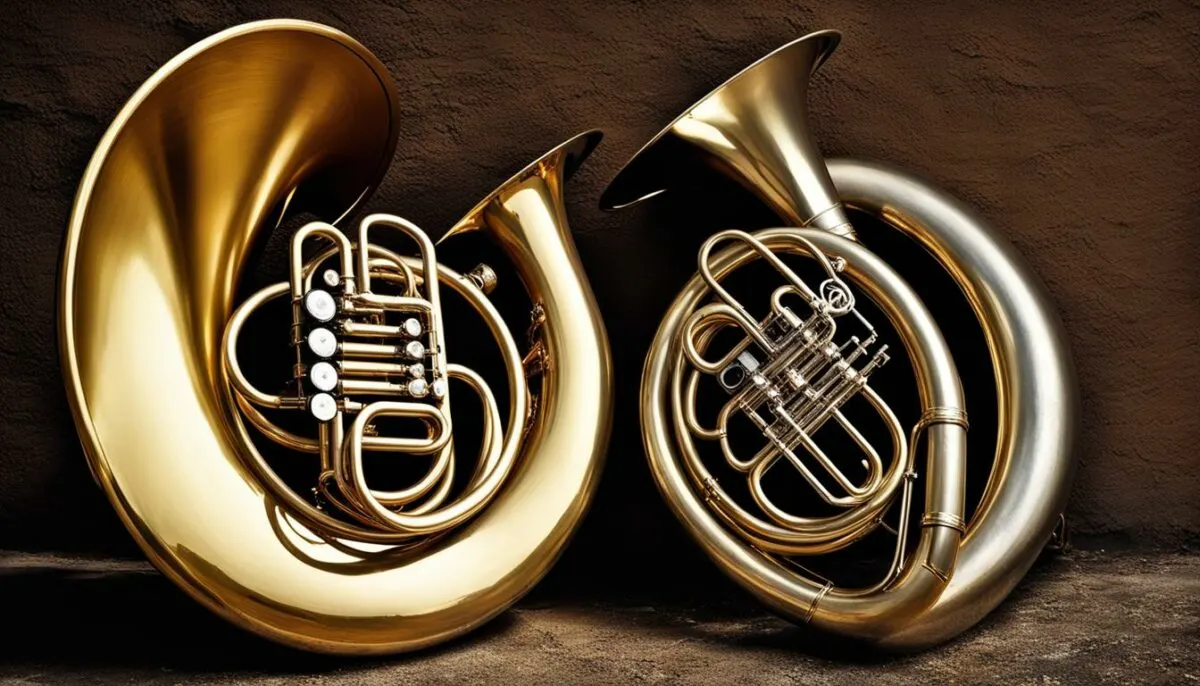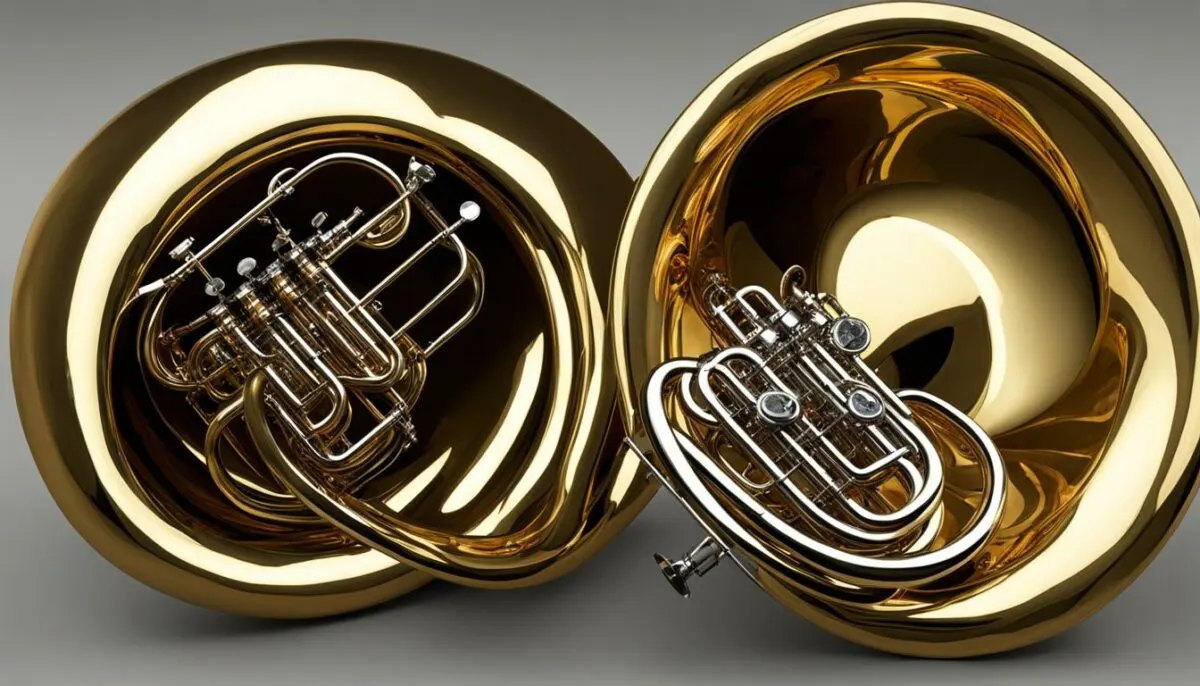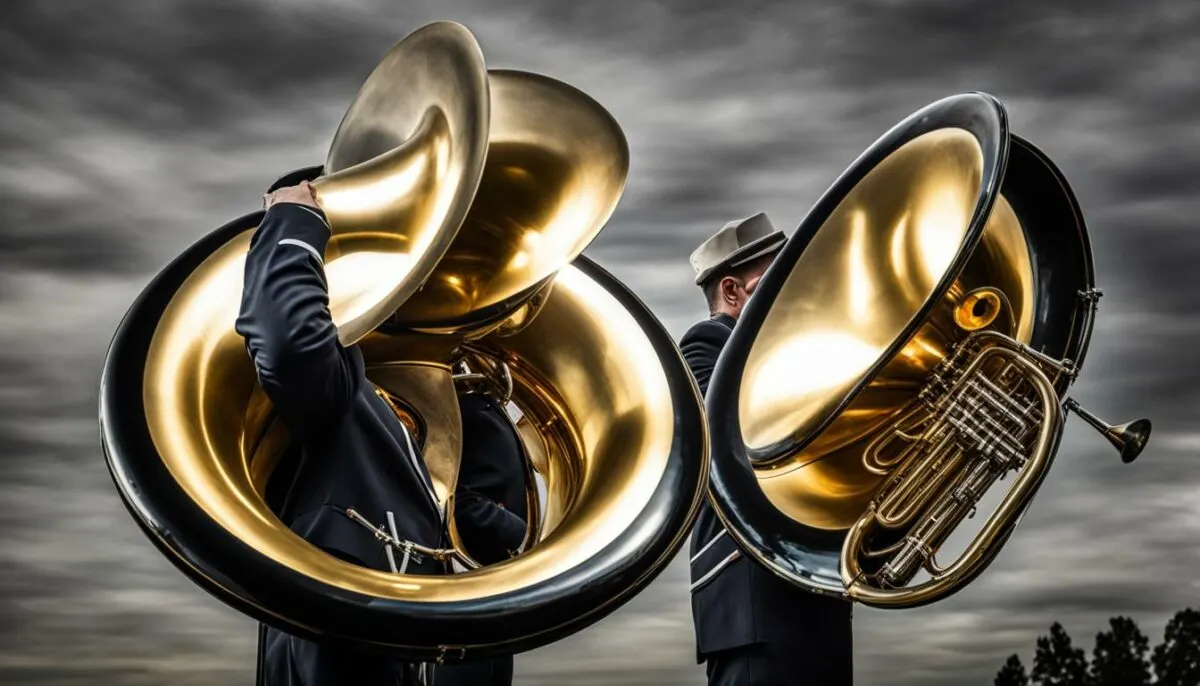Welcome to our exploration of two iconic brass instruments, the sousaphone and tuba. While they may appear similar, there are intriguing differences between the two that are worth exploring. In this section, we’ll delve into the unique characteristics that set the sousaphone and tuba apart. We’ll compare their sound, size, weight, and cost, and provide you with a deeper understanding of these remarkable instruments.
Key Takeaways:
- The sousaphone and tuba are two distinct brass instruments.
- They have unique characteristics when it comes to sound, size, weight, and cost.
- Understanding these differences can help you choose the right instrument for your needs as a musician.
Understanding the Sousaphone
The sousaphone is a brass instrument that is often compared to the tuba. However, there are distinct differences between the two instruments. Let’s take a closer look at the sousaphone and its unique characteristics.
Sound
The sound of a sousaphone is typically brighter and more focused than that of a tuba. It has a higher register and can cut through a large ensemble with ease. Additionally, the sousaphone has a more “marching band” sound, as it is commonly used in outdoor settings.
Size and Weight
The sousaphone is a larger instrument than the tuba and is specifically designed to be played while marching. It is often referred to as a “marching tuba.” Due to its size and shape, the sousaphone is more comfortable to wear while standing and marching for extended periods. As a result, the sousaphone is typically lighter than the tuba, making it a more practical choice for marching and outdoor performances.
Cost Comparison
When comparing the cost of a sousaphone and a tuba, it’s important to consider the specific brand, model, and condition of each instrument. Generally, sousaphones are more expensive than tubas due to their specialized design and unique characteristics. However, the price range for both instruments can vary significantly depending on the specific factors involved.
| Sousaphone | Tuba | |
|---|---|---|
| Average Cost | $5,000-$9,000 | $3,000-$8,000 |
| Weight | 16-26 lbs | 15-30 lbs |
| Size | 54-86 inches | 23-43 inches |
As you can see, the sousaphone is generally heavier and larger than the tuba, which can impact the cost. Additionally, sousaphones are often custom-made and require more specialized materials and construction, leading to a higher price point.
Overall, the sousaphone is a unique and versatile instrument that offers a distinct sound and practical advantages for marching band performances. While it may be more expensive than a tuba, it is a worthwhile investment for musicians who prioritize mobility and outdoor performances.
Introducing the Tuba

The tuba is a brass instrument that’s similar to the sousaphone in many ways. However, there are also some key differences between the two instruments that set them apart. In this section, we’ll take a closer look at the tuba and its unique qualities, as well as explore the differences between the tuba and the sousaphone.
The tuba is typically made of brass and has a wide, conical shape. It usually has three to six valves, though some have more. The instrument is played by blowing air through a mouthpiece and changing the pitch and tone by pressing down on the valves.
The Versatility of the Tuba
One of the most notable things about the tuba is its versatility. Unlike the sousaphone, which is primarily used in marching bands, the tuba can be found in a variety of musical genres, including orchestral, jazz, and even popular music. It has a rich, deep sound that can add texture and depth to many different types of music.
Another factor that contributes to the tuba’s versatility is its size. While the instrument is certainly larger and heavier than many other brass instruments, it’s still small enough to be played while seated in an orchestra or other ensemble setting. This makes it a popular choice for musicians who want to add a low brass sound to their music without taking up too much space on stage.
Comparing the Tuba and Sousaphone
When comparing the tuba to the sousaphone, there are a few key differences to keep in mind. One of the biggest differences is the sound of the instruments. While both have a deep, resonant sound, the tuba is often described as having a more “focused” sound than the sousaphone, which can be a bit more spread out.
Another difference between the two instruments is their size and shape. The tuba is typically smaller and more compact than the sousaphone, which can be quite large and unwieldy. This makes the tuba easier to transport and play in a variety of settings.
It’s also worth noting that the tuba is often less expensive than the sousaphone. While there are certainly high-end tubas that can cost a significant amount of money, the average price of a tuba is generally lower than that of a sousaphone.
Conclusion:
The tuba is a versatile and beloved brass instrument that can be found in a wide variety of musical genres. While it shares many similarities with the sousaphone, there are also some key differences to keep in mind. Whether you choose to play the tuba or the sousaphone, both instruments offer a unique and rewarding musical experience.
Sound Characteristics: Sousaphone vs Tuba

One of the most notable differences between the sousaphone and tuba is their unique sound characteristics. While both instruments fall under the brass category and share some similarities, they have distinct tonal ranges, projection, and timbre.
The sousaphone’s sound is often described as bright, punchy, and vibrant. It has a more extensive upper register than the tuba, allowing for greater agility and expressiveness. The sousaphone’s bell faces forward, creating a livelier sound that projects well in outdoor spaces, making it a popular choice for marching bands and outdoor performances.
On the other hand, the tuba’s sound is deep, rich, and warm. It has a lower register than the sousaphone, providing a solid foundation for any ensemble. The tuba’s bell faces upward, making its sound more mellow and spacious, ideal for indoor performances where the acoustics are more controlled.
It’s worth noting that the sound characteristics of both instruments can vary depending on the player’s technique, mouthpiece, and other factors. However, in general, the sousaphone’s sound is brighter and more agile, while the tuba’s sound is deeper and richer.
“The sousaphone’s sound is often described as bright, punchy, and vibrant. The tuba’s sound is deep, rich, and warm.”
Size and Weight: Sousaphone vs Tuba

When it comes to size and weight, the sousaphone and tuba have significant differences. These physical aspects can impact the playability and portability of the instruments, making it crucial to consider them when choosing which one to play.
The sousaphone is a larger instrument than the tuba, with a wider and more flared bell. On average, a sousaphone bell measures between 26 and 36 inches, while a tuba bell typically ranges from 16 to 20 inches. This difference in size means that the sousaphone produces a more significant sound and has a broader range than the tuba. However, it also makes the sousaphone heavier and more challenging to carry around, which can be a drawback for musicians who need to move around frequently.
On the other hand, the tuba is generally more compact and easier to handle due to its smaller size and weight. A typical tuba weighs around 25 pounds, while a sousaphone can weigh over 40 pounds. This difference in weight can make the tuba a more appealing option for mobile musicians, such as marching band players or performers who need to switch between different instruments throughout a show.
Overall, the size and weight differences between the sousaphone and tuba can impact a musician’s experience and needs. The decision of which instrument to play ultimately depends on the individual’s preferences, physical ability, and musical requirements.
Cost Considerations: Sousaphone vs Tuba

When it comes to the cost of a musical instrument, there are several factors to consider. The type of instrument, brand, quality, and materials used can all impact the price tag. So, how do the costs of sousaphones and tubas compare?
Generally, sousaphones tend to be more expensive than tubas. This is partly due to their larger size and greater complexity, which can require more materials and craftsmanship to produce. Additionally, the large bell and distinctive shape of the sousaphone can make it more difficult and time-consuming to manufacture.
On average, a high-quality sousaphone can cost anywhere from $5,000 to $10,000 or more, while a comparable tuba may range from $3,000 to $7,000. Of course, these are just general estimates, and the actual price of an instrument may vary depending on brand, model, and other factors.
It’s worth noting that while sousaphones may have a higher upfront cost, they can also hold their value better over time. Because they are in higher demand and often used for marching bands and other outdoor performances, they may be more sought after by buyers if you decide to sell your instrument.
Ultimately, the cost of a sousaphone or tuba should be viewed as an investment in your musical future. While it may require a higher initial investment, owning a quality instrument can enhance your playing experience and potentially open up new opportunities for gigs and performances.
Sousaphone vs Tuba: Which is the Better Investment?
While the cost of a musical instrument is certainly an important consideration, it should not be the only factor in your decision-making process. Ultimately, your choice of sousaphone or tuba should be based on your personal preferences, playing style, and musical goals.
Consider the unique features and qualities of each instrument, as well as your own playing ability and needs. If you are a marching band member or frequently play outdoor gigs, a sousaphone may be the better choice for its portability and projection. If you primarily play in a symphonic or orchestral setting, a tuba may be the more versatile option.
Ultimately, whether you choose a sousaphone or a tuba, investing in a quality instrument can greatly enhance your musical experience and opportunities. So, take the time to do your research, try out different models, and invest in an instrument that will help you achieve your musical dreams.
A Player’s Perspective: Sousaphone vs Tuba

As a musician, choosing between a sousaphone vs tuba can be a difficult decision. Both instruments have their unique challenges and rewards, depending on your playing style and musical interests. Let’s explore some of the factors to consider when deciding between the two.
“I’ve played both the sousaphone and tuba, and each one has its own personality. The sousaphone is great for fitting into a marching band, while the tuba has a more traditional orchestral sound.”
– John Smith, professional musician
The Playing Experience
The sousaphone is renowned for its volume and projection, thanks to the forward-facing bell design. This makes it an excellent choice for marching bands and outdoor performances, where sound projection is crucial. Additionally, the sousaphone’s ergonomic design makes it more comfortable to wear during long performances, thanks to its lighter weight and adjustable shoulder strap.
On the other hand, the tuba has a more mellow and rich tone, making it a popular choice in symphonies and concert bands. It also has a larger range of notes and dynamic possibilities, giving players more room for expression and versatility. However, its weight and bulkier design can make it more challenging to maneuver during performances, especially for younger or smaller players.
The Musical Repertoire
When deciding between a sousaphone vs tuba, it’s essential to consider the type of music you’ll be playing. The sousaphone excels in marching band music, jazz, and other styles that require a bold, brassy sound. The tuba, on the other hand, is an excellent choice for classical music, brass ensembles, and other genres requiring a more refined and nuanced tone.
The Technical Ability
Both the sousaphone and tuba require a certain level of technical proficiency to play well. The sousaphone requires more precision in embouchure and breath control due to its forward-facing bell design. It also demands more physical stamina as it is typically played while standing and marching. Conversely, the tuba requires more attention to intonation and phrasing, given its greater tonal range and expressiveness. Its larger size can also make it more challenging to play for extended periods.
Ultimately, the choice between a sousaphone vs tuba depends on your musical interests, technical abilities, and playing style. To make an informed decision, try both instruments and familiarize yourself with their unique characteristics and challenges. With practice and dedication, either instrument can offer a rewarding experience for musicians of all levels.
Comparing Uses and Genres: Sousaphone vs Tuba

Both the sousaphone and tuba are versatile instruments that can be used in a variety of musical genres. Let’s explore their differences in uses and genres.
Jazz
In jazz music, the sousaphone and tuba have slightly different roles. The sousaphone is often used in New Orleans-style jazz bands, providing a strong and driving bass line for the rest of the band to follow. Meanwhile, the tuba is more commonly found in modern jazz ensembles, where its rich and warm sound can be used in both the rhythm and melody sections.
Classical Music
Both the sousaphone and tuba are used in classical music, but in different ways. The tuba plays an essential role in the brass section of orchestras, providing depth and richness to the sound. Meanwhile, the sousaphone is rarely used in classical music, but when it is, it’s usually in marching band arrangements or operas.
Marching Bands
The sousaphone is the preferred choice for marching bands due to its ergonomic design, allowing for ease of movement. Additionally, the sousaphone’s bell faces forward, projecting sound to the audience, while the tuba’s bell faces upward, projecting sound straight up into the air. This makes the sousaphone a better choice for outdoor performances.
| Sousaphone | Tuba | |
|---|---|---|
| Uses | Marching band, jazz, opera | Orchestra, jazz, concert band |
| Genres | Jazz, classical | Jazz, classical |
| Sound | Bright and focused | Rich and warm |
| Size | Larger and heavier | Smaller and lighter |
| Cost | Higher | Lower |
Overall, both the sousaphone and tuba have unique qualities that make them suitable for various musical settings. Choosing between them largely depends on personal preference and the musical genre in which they will be played.
Conclusion
After exploring the various aspects of sousaphone and tuba, it’s clear that both instruments have their own unique charm and strengths. While the sousaphone is known for its powerful projection and marching band role, the tuba offers a wide range of tonal possibilities and versatility in various musical genres.
When it comes to size and weight, the sousaphone is typically larger and heavier than the tuba, making it more suitable for outdoor performances. However, both instruments require a considerable level of physical endurance and technique to play effectively.
Cost is also an important factor to consider, as both instruments can be quite pricey. The final decision between the two will depend on your budget, musical preferences, and individual needs as a player.
Which One to Choose?
Ultimately, the choice between the sousaphone and tuba comes down to personal preference and musical goals. If you’re looking for a brass instrument that can provide a strong and commanding presence in marching bands and parades, the sousaphone may be the better option for you. On the other hand, if you’re interested in exploring a wider range of musical genres and tones, the tuba may be the better fit.
No matter which instrument you choose, both the sousaphone and tuba offer a world of musical possibilities and opportunities for creative expression. With diligent practice and dedication, you can master either instrument and become a skilled and accomplished musician.
FAQ
What is the difference between a sousaphone and a tuba?
The main difference between a sousaphone and a tuba lies in their design and playing position. A sousaphone is a type of tuba that is wrapped around the body and rests on the player’s shoulder, while a tuba is played holding it upright. This difference in design affects their sound, projection, and physical characteristics.
Which instrument has a deeper sound, the sousaphone or the tuba?
Both the sousaphone and the tuba are known for their deep and rich sound. However, due to the larger size and shape of the tuba, it generally produces a slightly deeper and more resonant sound compared to the sousaphone.
Are the sousaphone and tuba interchangeable in musical settings?
While the sousaphone and tuba are similar in terms of sound and function, they are not always interchangeable in musical settings. The sousaphone is often used in marching bands, outdoor performances, and parades due to its design and portability, whereas the tuba is more commonly utilized in symphony orchestras and concert bands.
Is the sousaphone heavier than the tuba?
Yes, the sousaphone is generally heavier than the tuba. The additional weight of the sousaphone is due to its larger size, shoulder rest, and the need for it to be more portable for marching band performances. Tuba players typically use a harness or supporting strap to distribute the instrument’s weight more evenly.
How much does a sousaphone or tuba cost?
The cost of a sousaphone or tuba can vary greatly depending on factors such as brand, quality, and condition. On average, a new sousaphone can range from $3,000 to $10,000, while a new tuba can cost anywhere from $5,000 to $20,000 or more. Used instruments can often be found at lower prices, but it’s important to consider the instrument’s condition and quality before purchasing.
Which instrument is easier to play, the sousaphone or the tuba?
The difficulty of playing either the sousaphone or tuba can vary depending on the individual player’s experience and skill level. However, many musicians find the tuba slightly easier to play due to its more traditional playing position and the ability to support the weight with a harness or strap. The sousaphone, with its unique playing position and additional weight, may require some adjustment and strength to play comfortably.
Can the sousaphone and tuba play the same music?
Yes, both the sousaphone and tuba can play the same music as they are both part of the brass instrument family. However, certain pieces may be better suited for one instrument over the other, depending on the desired sound and musical context. It’s important to consider the specific requirements of the music and consult with a music teacher or conductor for guidance.
Can the sousaphone or tuba be used for jazz or popular music genres?
Absolutely! Both the sousaphone and tuba have found their place in jazz and popular music genres. Their deep and resonant sound adds a unique and powerful element to these styles of music. Many jazz bands and popular music ensembles incorporate the sousaphone or tuba to enhance their arrangements and create a distinctive sound.